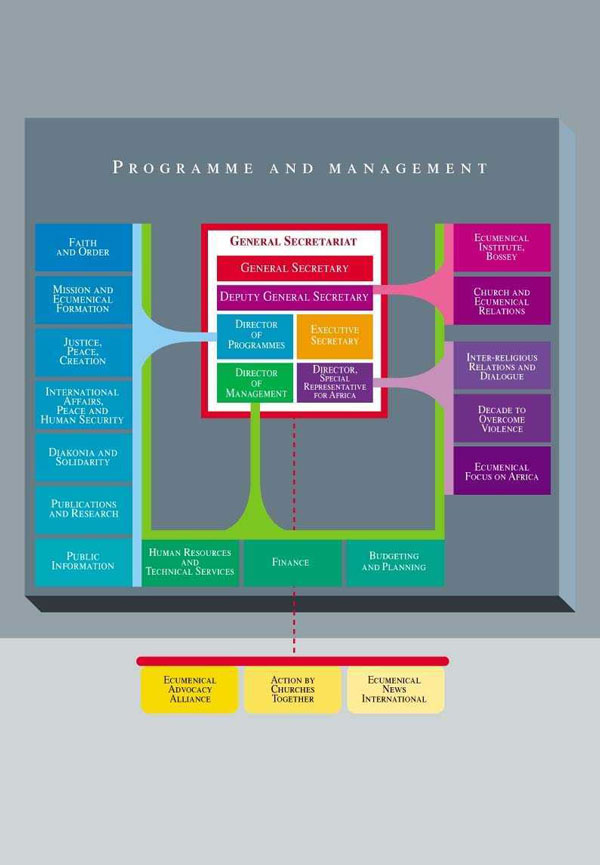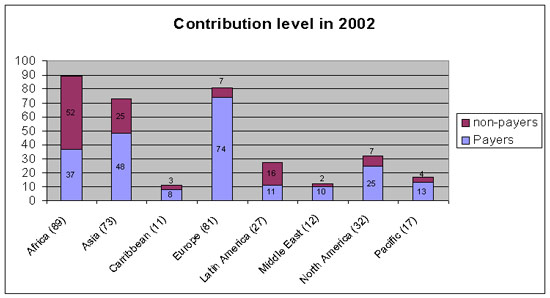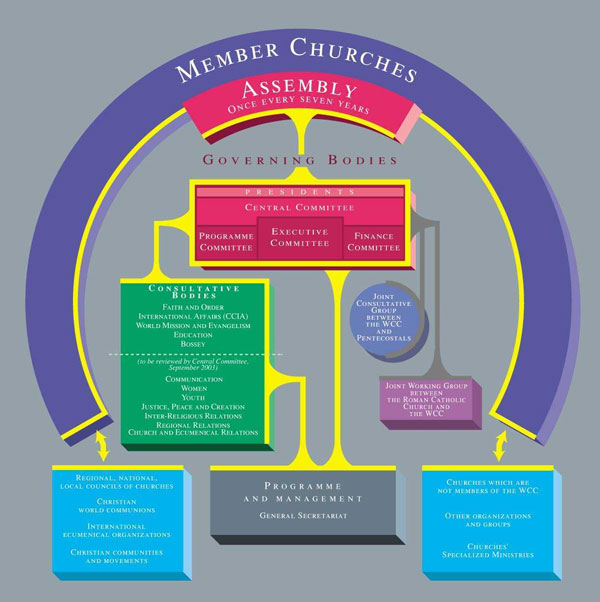
2003
YEARBOOK: FINANCES AND ORGANIZATION
![]() WCC
FINANCE
WCC
FINANCE
![]() MEMBERSHIP
INCOME IN 2002 - A STATISTICAL OVERVIEW
MEMBERSHIP
INCOME IN 2002 - A STATISTICAL OVERVIEW
![]() WCC
ORGANIGRAM
WCC
ORGANIGRAM
During 2002, financial concerns led the World Council of Churches to a series of discussions, reductions in expenditure and organizational reconfiguration. In April 2002, a WCC round table brought together in Geneva 32 representatives of partners, 12 representatives of the WCC programme committee and advisory bodies, as well as members of the WCC staff. The purpose of the meeting was to further dialogue between the WCC and its funding partners and to strengthen our ecumenical cooperation.
At its meeting in August/September 2002, the WCC central committee recognized that the financial projections of the previous year had not been borne out and that the World Council’s budget had become precariously unbalanced. The principal reasons for the deficit were identified as investment and foreign-currency losses and a decline in contributions income. The revised 2003 budget then established by the central committee required a reduction of expenditures by at least 6.6 million Swiss francs. Such an extensive adjustment of programmes and staff positions made it necessary to adapt the internal organization and the leadership structure of the Council. These changes were approved by the enlarged WCC officers’ meeting in November 2002.
The WCC’s revised organizational structure for 2003 is outlined by the charts.
As of January 2003, the WCC has only ten teams instead of the former fifteen:
The grouping of teams in clusters has been phased out, and the ten teams are coordinated by a director of programme and a director of management.
In the general secretariat, greater visibility is given to central policy concerns such as the Ecumenical Focus on Africa, the Decade to Overcome Violence, and Inter-Religious Relations and Dialogue. The deputy general secretary assumes overall responsibility for the area of church and ecumenical relations and continues to ensure liaison with the Ecumenical Institute, Bossey.
The main purpose of these changes is to ensure that the Council can be managed as one administrative whole with clear lines of responsibility and accountability. In its programmatic profile, it is intended to reflect the vision expressed in the CUV document (“A Common Understanding and Vision of the World Council of Churches”) adopted at Harare in 1998 and the mandate for action given by that WCC assembly.
In line with the CUV’s emphasis on strengthening relationships and cooperation within the fellowship of churches, more and more of the activities of the World Council are to be carried out in close cooperation with churches and ecumenical partner organizations. In the past, the main responsibility for certain activities already had been transferred from Geneva to some regional partners. The WCC officers now have decided to seek partnership arrangements with a view to continuing activities in the areas of Indigenous Peoples, the network of lay training centres, and regional cooperation in the Middle East and the Pacific, without relying any longer on specialized staff positions in Geneva.
Staff reductions: Earlier reductions, in 2001 and spring 2002, had increased the workload and pressure on the remaining staff. Therefore, it was found necessary to reorganize the programmes so that, together with a further reduction in staff numbers, some activities could be consolidated without weakening work around the core mandates of the Council. Such consolidation has taken place especially in the areas of communication, finance, support services and the US office of the WCC in New York City. Altogether, the present staff was to be reduced by at least 16 full-time equivalent positions (FTEs), bringing the total number to 141 FTEs or 158 persons on the WCC core staff. This means that in the seven years since 1995, the WCC will have reduced its staff complement by almost 50 percent.
Budget adjustments: Balances of designated funds available at the end of 2002 will be used in 2003, freeing undesignated income in 2003 for use in funding an “extraordinary budget”. The cost of all staff positions phased out or reduced – a non-recurring expenditure – has been included in the extraordinary budget. The net expenditure for the extraordinary budget is estimated at 2.8 million Swiss francs, an amount fully covered by the funds available. Taken together, these reductions will produce an overall saving of approximately 7.4 million Swiss francs. As a result, the WCC will have a balanced budget in 2003.
Further consolidation of the financial situation: The presentation of a balanced budget has been an important step in a strategy for stabilizing the financial situation of the WCC; however, additional steps will be necessary if this strategy is to have lasting effect. It is apparent that the steady decline in contributions income, at an average rate of 5 percent per year over the past three years, must be brought to a halt. This includes income both from the WCC’s traditional funding partners and from membership contributions.
A policy proposal submitted by year’s end and reviewed by the Executive
Committee in February 2003 asserted the principle that membership contributions
– which are essential for the core functioning of the World Council
of Churches – are to be considered as compulsory with non-payment
leading to the loss of membership benefits. Staff of the WCC were instructed
to develop a table of contribution levels to be calculated on the basis
of “an easily understandable, transparent and rational formula”
for presentation to the WCC central committee meeting in August 2003.
MEMBERSHIP INCOME IN 2002 – A STATISTICAL OVERVIEW
Contribution level in 2002: 226 churches, out of a total membership of 342, contributed CHF 6.5 million.
Evolution since 1998:
| Total no. of churches (in 2002) | Churches
which paid their contribution
|
||||||
| Africa | 89 |
|
|||||
| Asia | 73 |
|
|||||
| Caribbean | 11 |
|
|||||
| Europe | 81 |
|
|||||
| Latin America | 27 |
|
|||||
| Middle East | 12 |
|
|||||
| North America | 32 |
|
|||||
| Pacific | 17 |
|
|||||
342 |
|
Source of membership income: The following chart illustrates that the main sources of income, 95%, are from the churches based in the North:
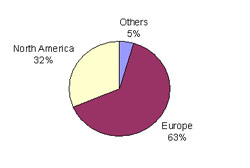
Comparison of church family distribution by membership and income:
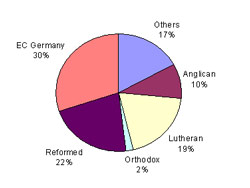
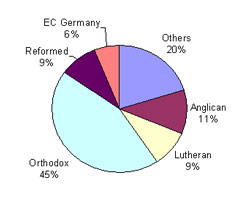
The Evangelical Church in Germany is composed of Lutheran, Reformed and United churches. Others = African Instituted, Baptist, Brethren, Free, Hussite, Methodist, non-denominational, Old Catholic, Pentecostal, united and uniting.
Highest payers in 2002:
| In real terms in CHF Proportionally by centimes/member | |||
| Evangelical Church in Germany | 1,986,199 | Evangelical Presbyterian Church of Portugal | 67 |
| Presbyterian Church (USA) | 689,186 | Moravian Church in Great Britain and Ireland | 65 |
| United Methodist Church | 559,879 | Synod of the Evangelical Church of Iran | 56 |
| Church of Sweden | 486,694 | Spanish Reformed Episcopal Church | 49 |
| Church of Norway | 298,500 | Church of Niue | 49 |
The above illustrates how the constituency of highest proportional paying churches varies somewhat from the highest paying in real terms.
The
10 million campaign:
The year 2002 heralded the mid-point of the Membership Income
Campaign with the goals, set at the 1998 General Assembly in Harare, to
be achieved by the 9th Assembly, to:
Membership
Income 1998-2002 |
|||||
| 1998 | 1999 | 2000 | 2001 | 2002 | |
| Number of churches paying | 172 | 189 | 193 | 163 | 226 |
| Percentage of 342 total (in 2002) | 50% | 55% | 56% | 48% | 66% |
| Income in CHF'000s | 6,067 | 6,269 | 6,689 | 6,308 | 6,537 |
| Increase from previous year | 3% | 7% | -6% | 4% | |
| Total contributions income | 52,781 | 50,255 | 47,965 | 45,136 | 41,954 |
| Part of the membership income | 11% | 12% | 14% | 14% | 16% |
While there has been considerable improvement on the number of churches contributing, income has remained almost stable. Its importance has, however increased when compared as a proportion of total contributions income.
Marching
into the future with confidence:
Given the overall global financial situation and diminishing
non-membership income, churches are to be lauded in managing to achieve
an overall increase. By mid 2003 income was ahead of budget at CHF 3,294,966
from 123 churches. By maintaining this spirit and a renewed effort the
goals of the campaign can become a reality.
